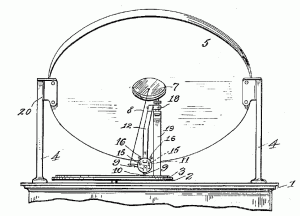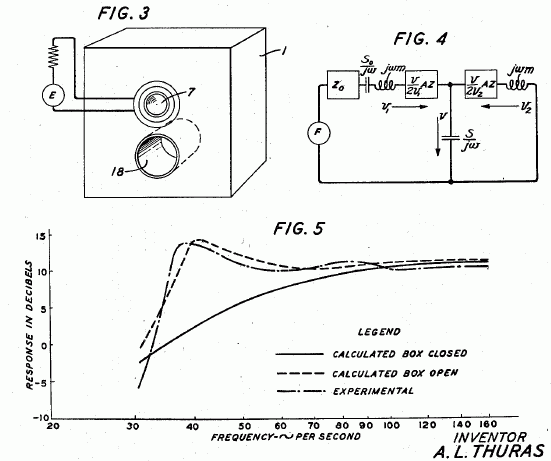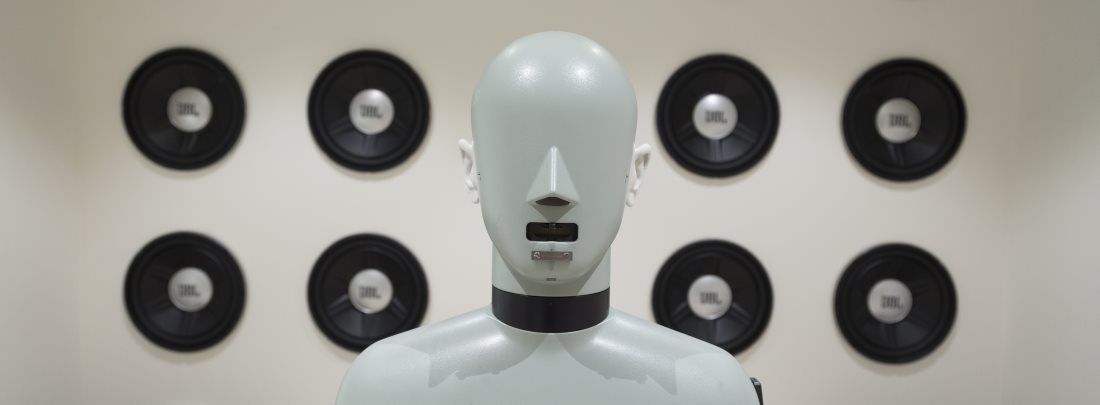Reis’ telephone was perhaps the first loudspeaker of any kind, as it employed a magnetostriction driver mounted in a resonating box. But it would still take many years before inventors discovered the virtues of baffles and enclosures. As Hunt puts it, the baffle is probably the most frequently rediscovered feature of loudspeaker art. Stokes, in 1868, pointed out that the radiation efficiency could be improved by preventing air circulation around the edges of a vibrating surface (the acoustic short-circuit). Rayleigh, a few years later, gave the now classic analysis of the radiation from a piston in an infinite baffle. But by the time loudspeakers were being produced in great numbers, Rayleigh’s Theory of Sound had been out of print for more than two decades, and many inventors discovered the baffle before they discovered Rayleigh.

Button, in a patent for a gramophone filed in 1919, describes a small diaphragm mounted in a finite baffle. Button wants to use the sound from both sides of the diaphragm, thereby producing exactness, clearness and a maximum volume of sound without the use of a tone arm, horn or megaphone construction. Keller of AT&T, in a patent interference with Thompson, was awarded claims for a open-back cabinet.

The closed cabinet was patented by Frederick of W.E. Co., and the closed cabinet with damping material was patented by Minton of RCA (although damping material is also mentioned in Frederick’s patent). Minton writes in his patent:
If the enclosed cavity behind the diaphragm is lined with some sound absorbing material, such as felt for example, there will be substantially no possibility of the waves from the rear of the diaphragm being reflected from the walls of the casing and therefore, no tendency to resonant effects. This material also, if properly chosen, will prevent the passage of sound through it and therefore, obviate any tendency of the casing itself to vibrate.
While the effects of the thin layer of felt suggested by Minton are overly optimistic, he at least understood the reasons for adding it in the first place.
A patent of considerable interest is the patent on baffles by Rice of G.E., filed in 1925. The patent covers various forms of open baffles and open back cabinets, and describes how to dimension a baffle for a given low frequency limit. Rice also describes the advantage on radiated power by restricting the radiation solid angle to half space, and the stiffening effect a closed cabinet has on the loudspeaker suspension, although he claims that this happens only at a certain frequency. He suggests ventilating the enclosed chamber to avoid this, and it can as such also be regarded as a preconception of the bass-reflex principle.
Several other inventors have suggested to have openings in the cabinet (Finch (1879), Colby (1887) and Merrill and Hays (1900) all have patents on some sort of vented enclosures), and as Hunt puts it,
there is a tendency to label as a forerunner of the bass-reflex principle any prior-art loudspeaker in which an incidental hole or side opening in the cabinet can be identified.
The closest prior-art patent is probably that of Steinberger of a telephone receiver with tubes connecting the front and rear of the diaphragm in order to secure “a better speech reproducing effect.”
There is no mention of the resonant effect of the tubes, though, only that
the diaphragm is more free to vibrate than has heretofore commonly been the case, such end following from the equalization of the air pressure upon the two sides of the diaphragm […].

The inventor of the bass-reflex principle is, without doubt, Albert L. Thuras of W.E. Co./BTL. His loudspeaker patent, filed in August, 1930, is a clear description of the governing principles in bass reflex enclosures. The equivalent diagram, with the correct volume velocities marked, fully describes the system, and the calculated response compares amazingly well with the theoretical response.
Another approach on what to do with the back radiation is exemplified in the transmission line. High (of Westinghouse) describes a device where the sound from the rear of the diaphragm is led of through a long concentric passage and combined with the front radiation with enough time delay to reinforce the low frequencies. Olney of the Stromberg-Carlson Telephone Manufacturing Company developed the principle in commercial form in the late 1930’s.

The main enclosure types have now been introduced, with the exception of the horn, which will be covered in the next part.
All images from published patents




